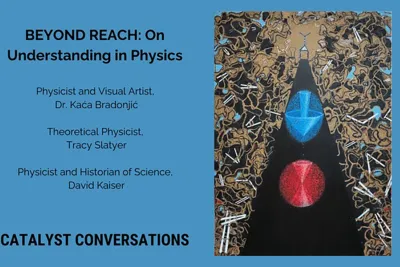Catalyst Conversations: BEYOND REACH: On Understanding in Physics
In partnership with Catalyst Conversations, the List Visual Arts Center presents BEYOND REACH: On Understanding in Physics. How does a physicist grapple with understanding the physical world that is beyond the reach of ordinary human perception?
Dr. Kaća Bradonjić, a physicist and a visual artist, approaches this question by focusing on subjective internal experiences that help researchers ground their scientific understanding; often dream-like, transient, and elusive, such experiences are rarely acknowledged in the formal presentations of scientific work, yet are an integral part of the research process. During her artist residency at the Institute for Artificial Intelligence and Fundamental Interactions at MIT, she collaborated with physicists to capture those experiences in an artistic form, guided by philosophy of phenomenology, embodied theories of cognition, and history of science. Bradonjić is joined by MIT’s theoretical physicist Tracy Slatyer and a physicist and a historian of science David Kaiser in a reflection on the experience of collaborative work, the role of subjective experience in scientific practice, and its relation to the collective scientific efforts.
Speaker Bios
Kaća Bradonjić is a visual artist and the Assistant Professor of Physics at Hampshire College. Crossing the borders of science, philosophy, and art, her work explores how various ways in which we experience, understand, and emotionally connect with the world affect our pursuit of knowledge. She holds a PhD in theoretical physics from Boston University and a BS in physics and philosophy from Northeastern University.
Tracy Slatyer is a theoretical physicist who works on particle physics, cosmology and astrophysics. Her research is motivated by questions of fundamental particle physics — in particular, the nature and interactions of dark matter — but she seeks answers to these questions by studying possible signatures of new physics in astrophysical and cosmological data. Her particular areas of focus include research into scenarios where the dark matter experiences new forces of nature, precision theoretical predictions for photon signals from heavy colliding dark matter particles, modeling of the possible effects of dark matter interactions on the history of the early cosmos, and hands-on data analysis of high-energy gamma-ray data in search of dark matter signals. She is a co-discoverer of the giant gamma-ray structures known as the “Fermi Bubbles” erupting from the center of the Milky Way.
David Kaiser is Germeshausen Professor of the History of Science and Professor of Physics at the Massachusetts Institute of Technology. He is the author of several award-winning books about modern physics, including How the Hippies Saved Physics: Science, Counterculture, and the Quantum Revival, and Quantum Legacies: Dispatches from an Uncertain World. Kaiser's physics research focuses on early-universe cosmology, working at the interface of particle physics and gravitation. He has also helped to design and conduct novel experiments to explore the foundations of quantum theory. A Fellow of the American Physical Society, Kaiser has received MIT's highest awards for excellence in teaching. His work has been featured in Science, Nature, the New York Times, and the New Yorker magazine. His group's recent efforts to conduct a "Cosmic Bell" test of quantum entanglement, in collaboration with Nobel laureate Anton Zeilinger, were featured in the documentary film Einstein's Quantum Riddle.
